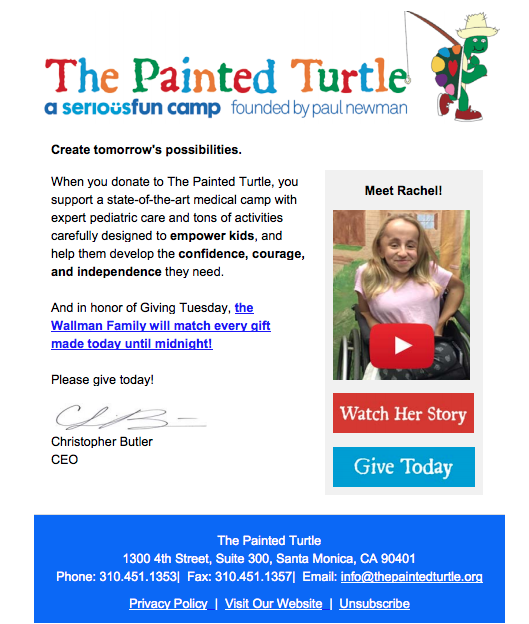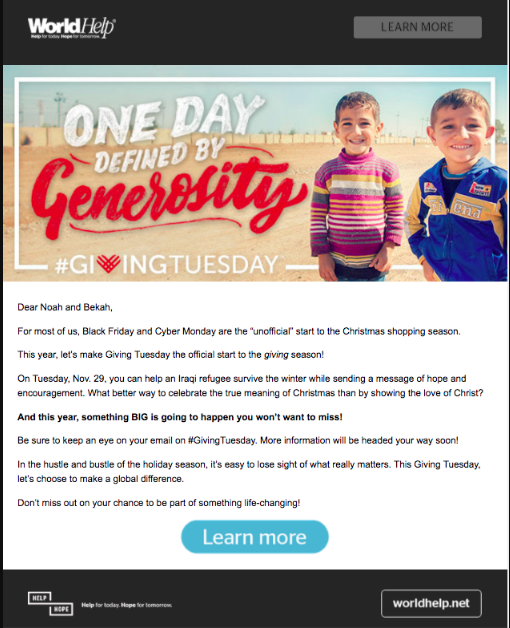#GivingTuesday has grown by leaps and bound since it started in 2012. Every year since then, more nonprofits and charities looking to engage an audience, raise money, and increase awareness for their cause capitalize on the power of collective giving fueled by this International Day of Giving.
Thankfully, all the effort that’s been put into educating people about #GivingTuesday is paying off! Last year, over $300 million was raised online—a number that’s expected to increase again this year. Horray!
Because #GivingTuesday occurs right after Thanksgiving and near the end of the year, it’s the perfect opportunity to raise money and awareness as a 24-hour fundraiser and/or as a kickstarter to a year-end campaign. The key to making this campaign work for you, however, is to have a well-rounded, strategic fundraising strategy.
Download your #GivingTuesday promotional email templates + examples
[amp-optin id=24995]
It goes without saying, but email should be one of the ways you reach your audience about your #GivingTuesday campaign. But, with the average adult receiving somewhere around 220 emails a day, you have to follow email best practices to ensure the email is read AND worthy of a response.
“Email should be one of the ways you reach your audience about your #GivingTuesday campaign.” tweet this
We spent some time analyzing a number of #GivingTuesday emails from nonprofits of every size, shape, and mission and found the same 5 common elements in each effective one. Here they are:
The 5 Elements Of A #GivingTuesday Email
1. Greeting and Familiarity
If you know your audience, especially their name, then it’s vital you use this information to address the email recipient.
Sometimes, this information isn’t readily available but that doesn’t mean you can’t achieve the same friendly, personal feeling by doing the following:
- Use a friend, familiar greeting such as “Dear Friends and Family” or simply “Hello!”
- Throughout the email, refer to the reader as “YOU”
- Address how you know the recipient. For example, thank them for donating to last year’s #GivingTuesday campaign or for serving as a volunteer.
2. Story + Visuals
Stories help motivate your reader to take action―It’s how you tug at their heartstrings and connect them emotionally to your cause. Stories are often told in written form, but visuals such as images and videos are also very effective.
For #GivingTuesday, try one of these story suggestions:
- Highlight a client helped by a previous #GivingTuesday campaign
- Explain a common problem of the population you serve and how your organization helps
- Create a visual that explains the number of lives impacted by a gift
3. Explained Impact
Speaking of “impact,” 24-hour fundraisers such as #GivingTuesday are one of the best ways to create an impact-based campaign. If your organization has a specific need, such as $X to expand a program or fund a new project or X number of fundraisers, it’s often best achieved during a time-sensitive campaign.
Regardless of what you plan to use the funds from #GivingTuesday to achieve, it’s important to communicate the intended impact with potential donors.
Your statement can be as simple as, “Your gift of $100 will feed a family 200 meals” or “By becoming a personal fundraiser, you’ll put our campaign in front of a new audience of 100 people who can help us meet our goal of serving 1,000 people in 2018.”
Some organization secure matching gifts or other incentives for #GivingTuesday. These should also be mentioned so your fundraiser and donors know if and how their donation may be leveraged.
4. A Clear Call To Action
After hooking the reader with your moving story and anticipated impact, it’s vital you tell them exactly what you want them to do. Don’t leave ‘em hanging!
Explain what you want them to do and how. For example, you can say, “Become a fundraiser for #GivingTuesday,” “Make your gift online” or “Help a Family In Need With Your Donation of $50.”
For more information on creating a compelling call to action, check out our resource on the subject.
5. Follow-Up Information
When the reader has a question or comment, they’re going to want to contact your organization. Therefore, it’s always a good idea to include the following so your audience can follow up if the need arises:
- Sign the email with the name of an employee or board member
- Include a link to your website and/or online donation site
- Add contact information, including a telephone number and address
For inspiration, take a look at this sample email sent out by our friends at The Painted Turtle. As you can see, they utilized the best practices outlined above in their #GivingTuesday email.

As always, World Help also sent a very effective pre-#GivingTuesday email to rally supporters for the big day. Notice now they made the effort to personalize the greeting and used a strong call to action “Learn More” to encourage the reader to learn about the campaign.

Email Template
Hello _________!
I’m reaching out to you because you’ve been such an integral part of our organization’s family. You have been a donor and volunteer— and your dedication has been essential in helping build a healthy, happy community.
As you know, during this special time of the year, it’s important to remember those of us who may struggle. ____, one of our clients, is one of those people who needs an extra boost in the winter months. Tell ____’s story.
By becoming a personal fundraiser or donating to our fundraiser on #GivingTuesday, you’ll ensure ____ and everyone like her gets the help she needs this winter.
Please consider creating a personal fundraiser page and recruiting friends and family to help your individual campaign. Or, think about giving a gift of $X on Tuesday. Either way, you can get started by following this link.
As always, your support is essential and very much appreciated.
Wishing you the best this holiday season,
___________________
President/CEO of _________
If you’re ready to get started with your #GivingTuesday campaign, remember that CauseVox makes creating a custom donation page easy. You can customize the URL, content, and include any information you want to ensure your donors give.
Then, simply link to your donation page in your #GivingTuesday email. In no time flat, you’ll be on your way to an effective campaign.
For more CauseVox #GivingTuesday resources, follow these links:
- #GivingTuesday: How To Plan A Successful Fundraising Campaign
- #GivingTuesday Ideas and Best Practices
- The Comprehensive Guide to Planning a #GivingTuesday Campaign
This post was originally published in October 2017 and has been updated.




